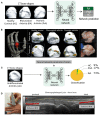Deep Learning-Based Classification of Inflammatory Arthritis by Identification of Joint Shape Patterns-How Neural Networks Can Tell Us Where to "Deep Dive" Clinically
- PMID: 35360728
- PMCID: PMC8960274
- DOI: 10.3389/fmed.2022.850552
Deep Learning-Based Classification of Inflammatory Arthritis by Identification of Joint Shape Patterns-How Neural Networks Can Tell Us Where to "Deep Dive" Clinically
Abstract
Objective: We investigated whether a neural network based on the shape of joints can differentiate between rheumatoid arthritis (RA), psoriatic arthritis (PsA), and healthy controls (HC), which class patients with undifferentiated arthritis (UA) are assigned to, and whether this neural network is able to identify disease-specific regions in joints.
Methods: We trained a novel neural network on 3D articular bone shapes of hand joints of RA and PsA patients as well as HC. Bone shapes were created from high-resolution peripheral-computed-tomography (HR-pQCT) data of the second metacarpal bone head. Heat maps of critical spots were generated using GradCAM. After training, we fed shape patterns of UA into the neural network to classify them into RA, PsA, or HC.
Results: Hand bone shapes from 932 HR-pQCT scans of 617 patients were available. The network could differentiate the classes with an area-under-receiver-operator-curve of 82% for HC, 75% for RA, and 68% for PsA. Heat maps identified anatomical regions such as bare area or ligament attachments prone to erosions and bony spurs. When feeding UA data into the neural network, 86% were classified as "RA," 11% as "PsA," and 3% as "HC" based on the joint shape.
Conclusion: We investigated neural networks to differentiate the shape of joints of RA, PsA, and HC and extracted disease-specific characteristics as heat maps on 3D joint shapes that can be utilized in clinical routine examination using ultrasound. Finally, unspecific diseases such as UA could be grouped using the trained network based on joint shape.
Keywords: arthritis; artificial intelligence; bone; deep learning; joint.
Copyright © 2022 Folle, Simon, Tascilar, Krönke, Liphardt, Maier, Schett and Kleyer.
Conflict of interest statement
The authors declare that the research was conducted in the absence of any commercial or financial relationships that could be construed as a potential conflict of interest.
Figures


References
-
- Ritchlin C, Colbert RA, Gladman DD. Psoriatic arthritis. In: Longo DL, editor. Moderate-to-Severe Psoriasis, Third Edition. Vol. 376. Waltham, MA: Massachusetts Medical Society; (2008). p. 239–58.
LinkOut - more resources
Full Text Sources
Research Materials
Miscellaneous

